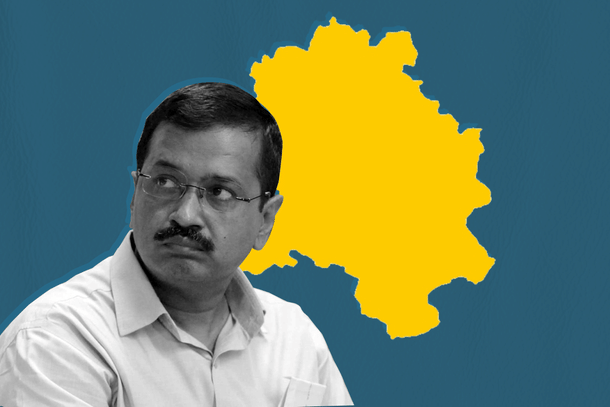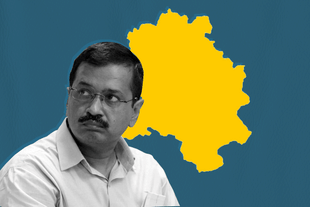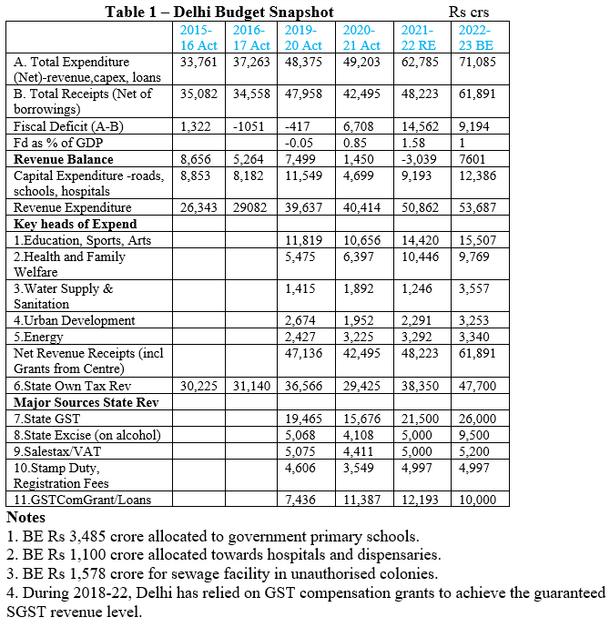Ideas
Decoding Delhi's Budget: Why Its Freebie Model Is Not Replicable
Sanjeev Nayyar
Oct 07, 2022, 11:51 AM | Updated 11:55 AM IST
Save & read from anywhere!
Bookmark stories for easy access on any device or the Swarajya app.


A Mint editorial says: “The Election Commission (EC) had added its voice to India’s debate on freebies. The conductor of polls reportedly wants political parties to tell voters before elections what their handout proposals would cost and how they would be funded”.
However, what is a freebie is very difficult to define.
Instead the editorial says, “What voters deserve, though, is a clear picture of state finances”.
This article does precisely that, look at the Delhi government’s (DG’s) budget numbers.
Why Delhi?
Because the Aam Aadmi Party that runs DG seeks to replicate the freebies offered to Delhi voters, like free power and water, in other states where it wants to come to power.
The Delhi fiscal deficit is projected at Rs 9,194 crore in FY23 (2022-23), against Rs 14,562 crore in the 2021-22 revised estimate (RE) and actuals of Rs 6,708 crore in 2020-21.
The corresponding percentage share of the fiscal deficit in gross domestic product (GDP) was 1, 1.58 and 0.85. These are well within the limit of 4 per cent laid down for states.
The revenue balance (excess of revenue receipts over revenue expenditure) is projected at Rs 7,601 crore in FY23, - Rs 3,039 crore in 2021-22 RE (budgeted surplus was Rs 1,271 crore) and actuals of Rs 1,450 crore in 2020-21 and Rs 5,264 crore in 2016-17.
The revenue balance is falling, and a projection has value only when actuals are close to projections.
The state’s own tax revenue is projected at Rs 47,700 crore in FY23 and Rs 38,350 crore in 21-22 RE — ie, an increase of 24.4 per cent. The actuals in 2020-21 were Rs 29,425 crore and Rs 31,140 crore in 2016-17.
Nearly half way through FY23, the projections lead to some observations.
State excise revenue was projected at Rs 9,500 crore against Rs 5,000 crore in 21-22 RE and actuals of Rs 4,108 crore in 2020-21.
In view of the withdrawal of the new excise policy on liquor and past performance, the FY23 number might not be realised.
The projected revenues from sales tax/VAT (value added tax) is Rs 5,200 crore in FY23 against Rs 5,000 crore in RE and actuals of Rs 4,411 crore in 2020-21.
Rs 10,000 crore is taken as goods and services tax (GST) compensation in FY23. In view of its withdrawal from July 2022, it will accrue for only three months. Thus, actuals would be lower.
Conversely, state GST collections will exceed FY23 projection of Rs 26,000 crore. Actuals (excluding GST on import of goods) for the period April to September 2022 were Rs 27,714 crore.
Here are some reasons for high GST revenues.
High per capita income. According to the state finance minister’s FY23 budget speech, Delhi’s per capita income at current prices in 2021-22 is likely to be Rs 401,982.
Also, Delhi has a population density of 11,320 (national average 382) according to the 2011 Census. Plus it attracts buyers from other states. These factors contribute to local sales.
Since GST is a destination-based tax, revenue increases. Further, the benefits of an integrated uniform tax system and economic recovery are getting reflected now.
Should any state be over-dependent on consumer spending and one source of revenue?
With high GST revenues, does Delhi need grants from the Centre? (FY23 Rs 12,589 crore)
Revenue from stamp duties and registrations hovers between Rs 4,500-Rs 5,000 crore. With the real estate sector picking up, the actuals may be higher than the FY23 projection of Rs 4,997 crore.
Expenditure: The state revenue expenditure is projected at Rs 53,687 crore in FY23 and Rs 50,862 crore in 21-22 RE, ie, an increase of 5.5 per cent.
The actuals in 2020-21 were Rs 40,114 crore and in 2016-17 Rs 29,082 crore.
The FY23 and FY22 budgets each allocated Rs 600 crore for subsidy to consumers for free water (FY21 Rs 467 crore) and Rs 3,250 crore and Rs 3,090 crore to the power distribution companies (discoms) (FY21 Rs 2,820 crore), being energy subsidies for consumers.
Note that the water subsidy was Rs 2 crore in 2014-15.
Should a scarce commodity like water be given free, more so when Delhi depends on other states for the majority of its supplies?
From the above it appears that subsidies were accounted for in the budget.
However, the amount of unfunded subsidy in the books of Delhi Jal Board, the discoms and the Delhi Transport Corporation is rarely spoken about.
Can the Delhi government fund such subsidies, for an informed assessment, in its next budget just like the Centre did for Food Corporation of India?
Some are calling this the Delhi Model and believe this can be replicated in other states. This is unlikely, because the gains from GST that Delhi makes due to its location cannot be replicated.
Further, it is not a full-fledged state like say Punjab or Gujarat, so does not have to incur costs that other states do (for example on police).
To put matters in perspective. In September 2022, out of a total GST revenue of Rs 1,05, 615 crore (excluding GST on import of goods), Delhi’s share was Rs 4,741 crore, (previous year Rs 3,605 crore), whilst the shares of much bigger states were Andhra Pradesh (Rs 3,132 crore), Rajasthan Rs 3,307 crore, Punjab Rs 1,710 crore and Madhya Pradesh Rs 2,711 crore. (Press Release).
What is of concern is that the FY23 budget provides Rs 1,298 crore for the development of unauthorised colonies.
The figure was Rs 1,550 crore in FY22 and Rs 1,700 crore in FY21. When governments fund the development of unauthorised colonies it puts a question mark on the need for authorised ones.
High consumption and GST revenues have put the Delhi government in a sweet spot. The government can create assets that will outlive it or fritter away resources in freebies with medium to long-term consequences.
All data courtesy PRS Legislative Research reports. Errors if any are regretted in advance (See detailed table below).

The writer is an independent columnist, travel photojournalist and chartered accountant, and founder of eSamskriti. He tweets at @sanjeev1927.





